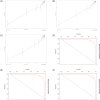Utilizing machine learning for survival analysis to identify risk factors for COVID-19 intensive care unit admission: A retrospective cohort study from the United Arab Emirates
- PMID: 38206939
- PMCID: PMC10783720
- DOI: 10.1371/journal.pone.0291373
Utilizing machine learning for survival analysis to identify risk factors for COVID-19 intensive care unit admission: A retrospective cohort study from the United Arab Emirates
Abstract
Background: The current situation of the unprecedented COVID-19 pandemic leverages Artificial Intelligence (AI) as an innovative tool for addressing the evolving clinical challenges. An example is utilizing Machine Learning (ML) models-a subfield of AI that take advantage of observational data/Electronic Health Records (EHRs) to support clinical decision-making for COVID-19 cases. This study aimed to evaluate the clinical characteristics and risk factors for COVID-19 patients in the United Arab Emirates utilizing EHRs and ML for survival analysis models.
Methods: We tested various ML models for survival analysis in this work we trained those models using a different subset of features extracted by several feature selection methods. Finally, the best model was evaluated and interpreted using goodness-of-fit based on calibration curves,Partial Dependence Plots and concordance index.
Results: The risk of severe disease increases with elevated levels of C-reactive protein, ferritin, lactate dehydrogenase, Modified Early Warning Score, respiratory rate and troponin. The risk also increases with hypokalemia, oxygen desaturation and lower estimated glomerular filtration rate and hypocalcemia and lymphopenia.
Conclusion: Analyzing clinical data using AI models can provide vital information for clinician to measure the risk of morbidity and mortality of COVID-19 patients. Further validation is crucial to implement the model in real clinical settings.
Copyright: © 2024 AlShehhi et al. This is an open access article distributed under the terms of the Creative Commons Attribution License, which permits unrestricted use, distribution, and reproduction in any medium, provided the original author and source are credited.
Conflict of interest statement
The authors have declared that no competing interests exist.
Figures




Similar articles
-
The Development and Validation of Simplified Machine Learning Algorithms to Predict Prognosis of Hospitalized Patients With COVID-19: Multicenter, Retrospective Study.J Med Internet Res. 2022 Jan 21;24(1):e31549. doi: 10.2196/31549. J Med Internet Res. 2022. PMID: 34951865 Free PMC article.
-
Characteristics and outcome of critically ill patients with coronavirus disease-2019 (COVID-19) pneumonia admitted to a tertiary care center in the United Arab Emirates during the first wave of the SARS-CoV-2 pandemic. A retrospective analysis.PLoS One. 2021 Oct 22;16(10):e0251687. doi: 10.1371/journal.pone.0251687. eCollection 2021. PLoS One. 2021. PMID: 34679109 Free PMC article.
-
Clinical Characteristics and Prognostic Factors for Intensive Care Unit Admission of Patients With COVID-19: Retrospective Study Using Machine Learning and Natural Language Processing.J Med Internet Res. 2020 Oct 28;22(10):e21801. doi: 10.2196/21801. J Med Internet Res. 2020. PMID: 33090964 Free PMC article.
-
Artificial Intelligence Functionalities During the COVID-19 Pandemic.Disaster Med Public Health Prep. 2023 Feb 27;17:e336. doi: 10.1017/dmp.2023.3. Disaster Med Public Health Prep. 2023. PMID: 36847255
-
Benchmarking of Machine Learning classifiers on plasma proteomic for COVID-19 severity prediction through interpretable artificial intelligence.Artif Intell Med. 2023 Mar;137:102490. doi: 10.1016/j.artmed.2023.102490. Epub 2023 Jan 18. Artif Intell Med. 2023. PMID: 36868685 Free PMC article. Review.
Cited by
-
Evolution of serious and life-threatening COVID-19 pneumonia as the SARS-CoV-2 pandemic progressed: an observational study of mortality to 60 days after admission to a 15-hospital US health system.BMJ Open. 2024 Jul 8;14(7):e075028. doi: 10.1136/bmjopen-2023-075028. BMJ Open. 2024. PMID: 38977360 Free PMC article.
-
A Systematic Review of the Outcomes of Utilization of Artificial Intelligence Within the Healthcare Systems of the Middle East: A Thematic Analysis of Findings.Health Sci Rep. 2024 Dec 24;7(12):e70300. doi: 10.1002/hsr2.70300. eCollection 2024 Dec. Health Sci Rep. 2024. PMID: 39720235 Free PMC article. Review.
References
-
- Dyusupova A., Faizova R., Yurkovskaya O., Belyaeva T., Terekhova T., Khismetova A., et al.. Clinical characteristics and risk factors for disease severity and mortality of COVID-19 patients with diabetes mellitus in Kazakhstan: A nationwide study. Heliyon. 7, e06561 (2021,3), https://www.sciencedirect.com/science/article/pii/S2405844021006642 - PMC - PubMed
-
- Nemati M., Ansary J. & Nemati N. Machine-Learning Approaches in COVID-19 Survival Analysis and Discharge-Time Likelihood Prediction Using Clinical Data. Patterns. 1, 100074 (2020,8), https://www.sciencedirect.com/science/article/pii/S2666389920300945 - PMC - PubMed
-
- Soltan A., Kouchaki S., Zhu T., Kiyasseh D., Taylor T., Hussain Z., et al.. Rapid triage for COVID-19 using routine clinical data for patients attending hospital: development and prospective validation of an artificial intelligence screening test. The Lancet Digital Health. 3, e78–e87 (2021,2), Publisher: Elsevier doi: 10.1016/S2589-7500(20)30274-0 - DOI - PMC - PubMed
MeSH terms
LinkOut - more resources
Full Text Sources
Medical
Research Materials

